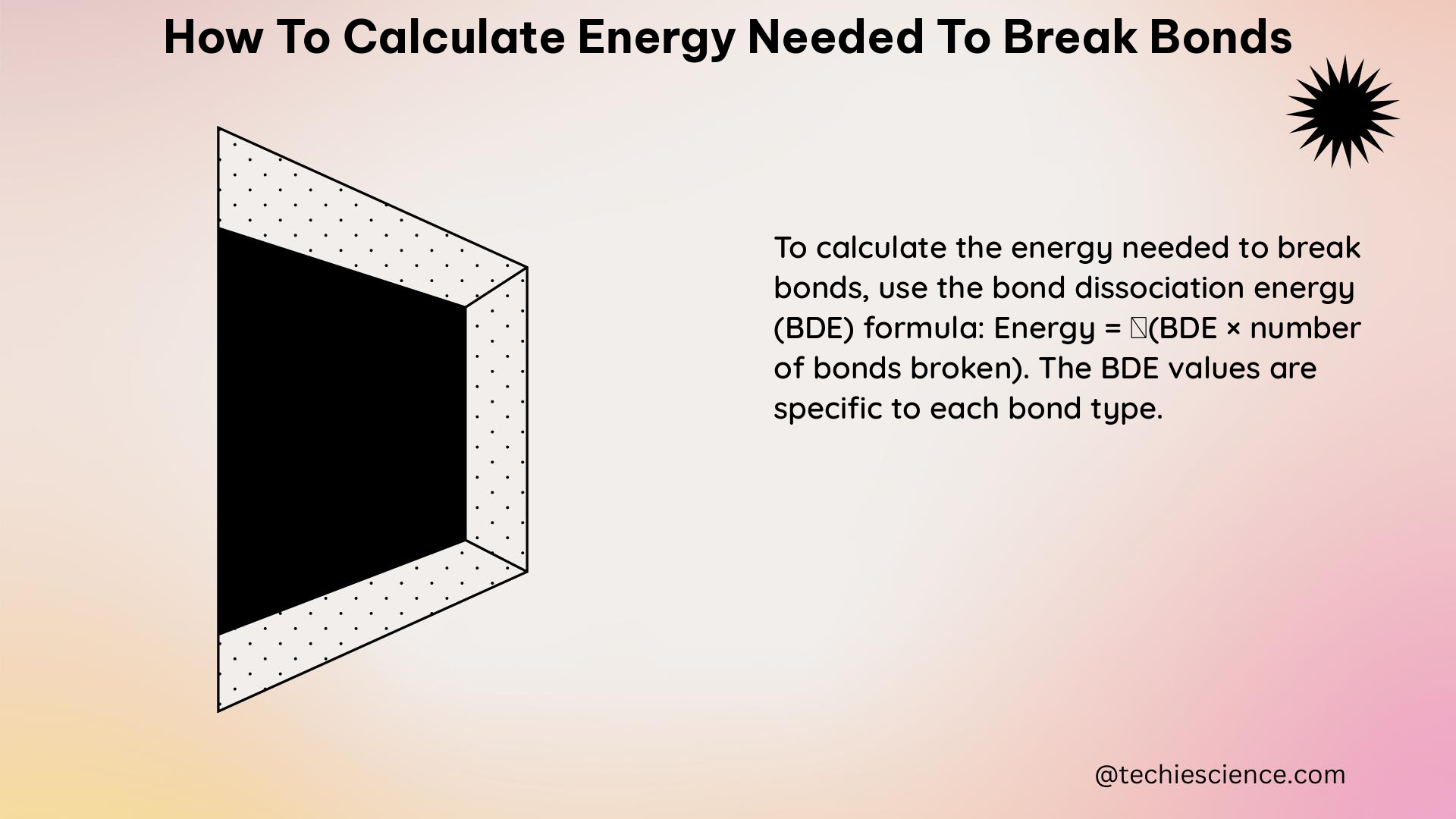When it comes to understanding chemical reactions, the concept of bond energy or bond enthalpy is crucial. Bond energy is the energy required to break a chemical bond between two atoms in a molecule, and it is typically measured in kilojoules per mole (kJ/mol). By understanding how to calculate the energy needed to break bonds, we can gain valuable insights into the energetics of chemical processes.
Understanding Bond Energy
The bond energy of a chemical bond is the amount of energy required to break that bond. It represents the strength of the attraction between the atoms involved in the bond. The higher the bond energy, the stronger the bond and the more energy is required to break it.
Bond energy values are typically obtained from experimental data or calculated using theoretical models. These values are specific to the type of bond and the atoms involved. For example, the bond energy of a C-H bond is different from the bond energy of an O-H bond.
Calculating the Energy Needed to Break Bonds

To calculate the energy needed to break bonds, we can use the following formula:
ΔH = Σ(bond energies of reactants) - Σ(bond energies of products)
Where:
– ΔH is the enthalpy change, which represents the energy needed to break the bonds.
– Σ(bond energies of reactants) is the sum of the bond energies of the reactants.
– Σ(bond energies of products) is the sum of the bond energies of the products.
The bond energies are typically expressed in kJ/mol.
Example Calculation
Let’s consider the reaction between hydrogen and chlorine to form hydrogen chloride:
H2 + Cl2 → 2HCl
The bond energy of a H-H bond is 436 kJ/mol, the bond energy of a Cl-Cl bond is 243 kJ/mol, and the bond energy of a H-Cl bond is 432 kJ/mol.
To calculate the energy needed to break the bonds in the reactants, we add the bond energies of the H-H and Cl-Cl bonds:
Energy in = 436 kJ/mol + 243 kJ/mol = 679 kJ/mol
To calculate the energy released when the bonds in the products form, we multiply the bond energy of the H-Cl bond by 2 (since there are 2 H-Cl bonds in the products):
Energy out = 2 × 432 kJ/mol = 864 kJ/mol
Finally, we calculate the energy needed to break the bonds by subtracting the energy out from the energy in:
Energy change = Energy in - Energy out = 679 kJ/mol - 864 kJ/mol = -185 kJ/mol
The negative sign indicates that energy is being absorbed by the system, which is consistent with our understanding that energy is needed to break bonds.
Factors Affecting Bond Energy
Several factors can influence the bond energy of a chemical bond, including:
-
Atomic Electronegativity: The difference in electronegativity between the atoms involved in the bond can affect the bond energy. Bonds between atoms with a larger electronegativity difference tend to have higher bond energies.
-
Bond Length: The distance between the atoms in a bond can also affect the bond energy. Shorter bond lengths generally result in higher bond energies.
-
Bond Type: The type of bond (e.g., covalent, ionic, metallic) can also influence the bond energy. Covalent bonds typically have higher bond energies than ionic or metallic bonds.
-
Hybridization: The hybridization of the atoms involved in the bond can affect the bond energy. Different hybridization states can result in different bond energies.
-
Resonance Stabilization: In some cases, the presence of resonance structures can stabilize the bond and increase the bond energy.
Practical Applications
The ability to calculate the energy needed to break bonds has numerous practical applications in various fields, including:
-
Chemical Reactions: Understanding the energy required to break bonds can help predict the feasibility and direction of chemical reactions, as well as the energy changes involved.
-
Thermochemistry: Bond energy calculations are essential in thermochemistry, where they are used to determine the enthalpy changes associated with chemical reactions.
-
Material Science: Bond energy data is crucial in understanding the properties and behavior of materials, such as their strength, stability, and reactivity.
-
Energy Production: Bond energy calculations are important in the development of energy-efficient processes and the design of new energy sources, such as in the field of renewable energy.
-
Environmental Chemistry: Bond energy data can be used to analyze the stability and reactivity of environmental pollutants, which is crucial for understanding their fate and impact on the environment.
Conclusion
Calculating the energy needed to break bonds is a fundamental concept in chemistry and physics. By understanding the principles of bond energy and the factors that influence it, we can gain valuable insights into the energetics of chemical processes and their practical applications. This comprehensive guide has provided you with the necessary tools and knowledge to effectively calculate the energy needed to break bonds, empowering you to tackle a wide range of problems in the field of chemistry and beyond.
References
- BBC Bitesize – Bond energy calculations – Energy changes in chemical reactions: https://www.bbc.co.uk/bitesize/guides/zdy8jty/revision/3
- Bond Energy Calculations & Enthalpy Change Problems, Basic: https://www.youtube.com/watch?v=0Tm6JMeYX5g
- Chemical Bonding – Bond Energies: https://chem.libretexts.org/Bookshelves/Physical_and_Theoretical_Chemistry_Textbook_Maps/Supplemental_Modules_%28Physical_and_Theoretical_Chemistry%29/Chemical_Bonding/Fundamentals_of_Chemical_Bonding/Bond_Energies

The lambdageeks.com Core SME Team is a group of experienced subject matter experts from diverse scientific and technical fields including Physics, Chemistry, Technology,Electronics & Electrical Engineering, Automotive, Mechanical Engineering. Our team collaborates to create high-quality, well-researched articles on a wide range of science and technology topics for the lambdageeks.com website.
All Our Senior SME are having more than 7 Years of experience in the respective fields . They are either Working Industry Professionals or assocaited With different Universities. Refer Our Authors Page to get to know About our Core SMEs.